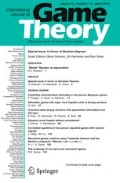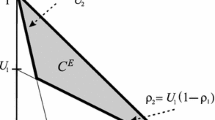Abstract
This paper shows that if a game satisfies the sufficient condition for the existence and uniqueness of a pure-strategy Nash equilibrium provided by Rosen (Econometrica 33:520, 1965), then the game has a unique correlated equilibrium, which places probability one on the unique pure-strategy Nash equilibrium. In addition, it shows that a weaker condition suffices for the uniqueness of a correlated equilibrium. The condition generalizes the sufficient condition for the uniqueness of a correlated equilibrium provided by Neyman (Int J Game Theory 26:223, 1997) for a potential game with a strictly concave potential function.
Similar content being viewed by others
References
Aumann RJ (1974) Subjectivity and correlation in randomized strategies. J Math Econ 1:67–96
Aumann RJ (1987) Correlated equilibrium as an expression of Bayesian rationality. Econometrica 55:1–18
Gabay D, Moulin H (1980) On the uniqueness and stability of Nash equilibria in noncooperative games. In: Bensoussan A, Kleindorfer P, Tapiero CS (eds) Applied stochastic control in econometrics and management science. North-Holland, Amsterdam, pp 271–294
Hart S, Schmeidler D (1989) Existence of correlated equilibria. Math Oper Res 14:18–25
Hartman P, Stampacchia G (1966) On some nonlinear elliptic differential functional equations. Acta Math 115:271–310
Liu L (1996) Correlated equilibrium of Cournot oligopoly competition. J Econ Theory 68:544–548
Monderer D, Shapley LS (1996) Potential games. Games Econ Behav 14:124–143
Morris S, Ui T (2004) Best response equivalence. Games Econ Behav 49:260–287
Nagurney A (1993) Network economics: a variational inequality approach. Kluwer Academic Publishers, Dordrecht
Neyman A (1997) Correlated equilibrium and potential games. Int J Game Theory 26:223–227
Rosen JB (1965) Existence and uniqueness of equilibrium points for concave N-person games. Econometrica 33:520–534
Slade ME (1994) What does an oligopoly maximize? J Ind Econ 42:45–61
Author information
Authors and Affiliations
Corresponding author
Additional information
I thank the editor, an associate editor, and an anonymous referee for detailed comments and suggestions, which have substantially improved this paper. Special thanks are due to the referee for pointing out Lemmas 4 and 5. I acknowledge financial support by The Japan Economic Research Foundation and by MEXT, Grant-in-Aid for Scientific Research. All remaining errors are mine.
Rights and permissions
About this article
Cite this article
Ui, T. Correlated equilibrium and concave games. Int J Game Theory 37, 1–13 (2008). https://doi.org/10.1007/s00182-007-0098-x
Accepted:
Published:
Issue Date:
DOI: https://doi.org/10.1007/s00182-007-0098-x




